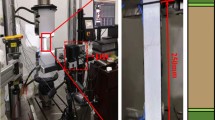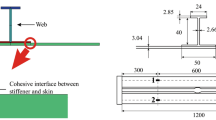Abstract
A comprehensive consideration of delamination location, delamination size and delamination quantity was focused to determine a quantitative evaluation of the influence of delamination on the tensile strength of T-stiffened panels under the out-of-plane tensile load. Moreover, the failure behavior of T-stiffened panels without delamination and those with delamination under tensile loading was also examined. A characteristic parameter about delamination in the stiffener/panel interface was proposed by means of the ratio (Sr) of the delamination size in the filler/panel interface to the filling area in the filler/panel interface. It is found that the delamination located closely to the stiffener/panel interface, especially closely to the filler/panel interface has the most significant influence on the tensile strength. Another interesting observation is that delamination in the stiffener/panel interface and the stiffener corner also changes the failure mode which cracks along the interior of panels near the adhesive layer.












Similar content being viewed by others
References
Xie PP, Zhu S, Shao YY, Peng WF, Zhan LH, Li SJ (2019) Simulation and experimental analysis of autoclave co-curing CFRP hat-stiffened panels with silicone airbag mandrels. Iran Polym J 28:505–514
Kim HS, Lee DG (2007) Reduction of fabricational thermal residual stress of the hybrid co-cured structure using a dielectrometry. Compos Sci Technol 67:29–44
Toftegaard H, Lystrup A (2005) Design and test of lightweight sandwich T-joint for naval ships. Compos Part A Appl Sci Manuf 36:1055–1065
Herencia JE, Weaver PM, Friswell MI (2008) Initial sizing optimization of anisotropic composite panels with T-shaped stiffeners. Thin Walled Struct 46:399–412
Shishesaz M, Hosseini M (2020) Effects of joint geometry and material on stress distribution, strength and failure of bonded composite joints: an overview. J Adhes 96:1053–1121
Huang CK (2003) Study on co-cured composite panels with blade-shaped stiffeners. Compos Part A Appl Sci Manuf 34:403–410
Ma XQ, Gu YZ, Li M, Li YX, Zhang ZG (2014) Investigation of carbon fiber composite stiffened skin with vacuum assisted resin infusion/prepreg co-curing process. Sci China Technol Sci 57:1956–1966
Kim GH, Choi JH, Kweon JH (2010) Manufacture and performance evaluation of the composite hat-stiffened panel. Compos Struct 92:2276–2284
Yang XB, Zhan LH, Zhao X, Jiang CB (2020) Analysis of porosity and mechanical behavior of composite T-joints produced by random vibration-assisted vacuum processing. Iran Polym J 29:759–770
Koh TM, Isa MD, Feih S, Mouritz AP (2013) Experimental assessment of the damage tolerance of z-pinned T-stiffened composite panels. Compos Part B 44:620–627
Phillips HJ, Shenoi RA (1998) Damage tolerance of laminated tee joints in FRP structures. Compos Part A Appl Sci Manuf 29A:465–478
Tan RM, Guan ZD, Sun W, Liu Z, Xu JF (2018) Experiment investigation on impact damage and influences on compression behaviors of single T-stiffened composite panels. Compos Struct 203:486–497
Ayensa A, Oller E, Beltran B, Ibzrz E, Mari A, Gracia L (2019) Influence of the flanges width and thickness on the shear strength of reinforced concrete beams with T-shaped cross section. Eng Struct 188:506–518
Bigaud J, Aboura Z, Martins AT (2018) Analysis of the mechanical behavior of composite T-joints reinforced by one side stitching. Compos Struct 184:249–255
Bai RX, Lei ZK, Wei X, Tao W, Yan C (2017) Numerical and experimental study of dynamic buckling behavior of a J-stiffened composite panel under in-plane shear. Compos Struct 166:96–103
Justo J, Reinoso J, Blázquez A (2017) Experimental failure investigation of pull-off tests of single T-stiffened composite specimens. Compos Struct 177:13–27
Ma XS, Liu HG, Bian K, Lu JY, Xiong K (2020) A numerical and experimental study on the multiple fracture progression of CFRP T-joints under pull-off load. Int J Mech Sci 177:227–237
Denis DR, Cartie GA (2006) 3D reinforcement of stiffener-to-skin T-joints by Z-pinning and tufting. Eng Fract Mech 73:2532–2540
Freitas M, Carvalho R (2006) Residual strength of a damaged laminated CFRP under compressive fatigue stresses. Compos Sci Technol 66:373–378
Baldi A, Airoldi A, Crespi M (2011) Modelling competitive delamination and debonding phenomena in composite T-Joints. Procedia Eng 10:3483–3489
Ye YY, Zhu WD, Jiang JX, Xu Q, Ke YL (2019) Computational modelling of post-buckling behavior of composite T-stiffened panels with different bonding methods. Compos Part B 166:247–256
Mo YM, Ge DY, He BL (2016) Experiment and optimization of the hat-stringer-stiffened composite panels under axial compression. Compos Part B 84:285–293
Stickler PB, Ramulu M, Johnson PS (2000) Experimental and numerical analysis of transverse stitched T-joints in bending. Compos Struct 50:17–27
Cui H (2014) Delamination and debonding failure of laminated composite T-joints. PhD thesis, Delft University of Technology
Marcadon V, Nadot Y, Roy A, Gacougnolle JL (2006) Fatigue behavior of T-joints for marine applications. Int J Adhes Adhes 26:481–489
Wang Y, Soutis C (2017) Fatigue behavior of composite T-joints in wind turbine blade applications. Appl Compos Mater 24:461–475
Wang XM, Xie FY, Li M (2009) Correlated rules between complex structure of composite components and manufacturing defects in autoclave molding technology. J Reinf Plast Compos 28:2791–2803
Li M, Wang XM, Xie FY, Zhang ZG (2009) Influence of fillers in stiffener core and structural parameters on compaction of T-stiffened skins in autoclave process. Polym Polym Compos 17:273–280
Kumar NJ, Kumar KM, Babu PR(2015) Delamination Damage Propagation Studies of Laminated Composite Stiffened Panels. Int J Eng Res Appl ISSN: 2248-9622 (NCDATES-09th and 10th January 2015):18–24
Li MJ, Chen PH, Kong B, Peng T, Yao ZL (2016) Influences of thickness ratios of flange and skin of composite T-joints on the reinforcement effect of Z-pin. Compos Part B 97:216–225
Dharmawan F, Thomson RS, Li H, Herszberg I, Gellert E (2004) Geometry and damage effects in a composite marine T-joint. Compos Struct 66:181–187
Trask RS, Hallett SR, Helenon FMM, Wisnom MR (2012) Influence of process induced defects on the failure of composite T-joint specimens. Compos Part A Appl Sci Manuf 43:748–757
Wang XM, Li SL, Xie FY (2020) Investigation on performance evaluation of composite T-Stiffened skins fabricated by integral molding technologies under tensile loading. Appl Compos Mater 27:795–809
Wang XM, Xie FY (2013) Probabilistic analysis method and sub-cluster theory model of delamination for composite components. J Aeronaut Mater 33:72–76
Acknowledgements
The authors acknowledge the support of the funding from AVIC Composite Corporation LTD (Grant No. GC732011601).
Author information
Authors and Affiliations
Corresponding author
Rights and permissions
About this article
Cite this article
Wang, X., Xie, F. Tensile strength and failure behavior of T-stiffened panels with embedded delamination: experimental investigation. Iran Polym J 30, 897–905 (2021). https://doi.org/10.1007/s13726-021-00938-5
Received:
Accepted:
Published:
Issue Date:
DOI: https://doi.org/10.1007/s13726-021-00938-5




